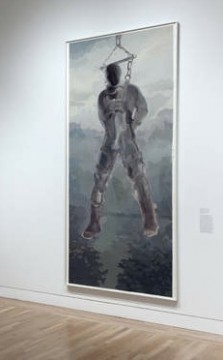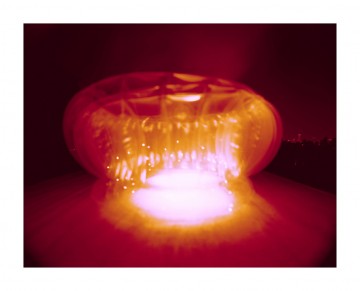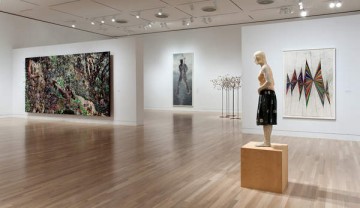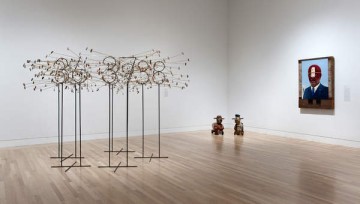
Monica Majoli, "Hanging Rubberman #1," 2006. Watercolor and gouache on paper, 123 x 51 in. Photo: Brian Forrest. Image via hammer.ucla.edu
Last week, Art21 treated Angelenos to the very first preview screening of William Kentridge: Anything is Possible at the Hammer Museum‘s Billy Wilder Theater. As Art21’s executive director Susan Sollins noted in her opening remarks, the Hammer was an ideal host, as the two organizations share a common vision. With innovative programming and impeccable curatorial focus, the Hammer has emerged, in recent years, as a leading supporter of 21st-century art.
Beginning in 2005, the Hammer Museum launched an initiative to build a strong permanent collection of contemporary art. The current exhibition of 42 works, Selections from the Hammer Contemporary Collection, emphasizes depth as well as breadth, highlighting many artists who have been featured in previous Hammer exhibitions. Indeed, there is notable overlap with the Hammer’s celebrated 2007 invitational exhibition, Eden’s Edge, with standouts such as Elliott Hundley, Mark Bradford (Season 4), and Monica Majoli. Of course we all know that the world has changed drastically in the past three years, and while the work in Eden had dark undertones, the vibe of the current Hammer exhibition is much closer to Revelation than Genesis.

Installation view from "Selections from the Hammer Contemporary Collection." Photo: Brian Forrest. From left to right: Ken Price, "Dream Balls," 2001; Elliott Hundley, "Pentheus," 2009; Evan Holloway, "35-39," 2007; Kristen Morgin, "Untitled (Scooters)"; Mark Grotjahn, "Untitled (Color Butterfly 10 Wings)," 2004; and Kara Walker, "Every Painting Is a Dead Nigger Waiting to Be Born," 2009. Via hammer.ucla.edu
In the second season of Art:21, Kara Walker characterizes the antebellum imagery in her work as an “illusion that [the work] is about past events. I tend to approach the complexities of my own life by distancing myself and finding a parallel in something prettier and more gentile, like the picture of the old South….”
Presented in Los Angeles for the first time, Walker’s suite of 20 gouache on paper works, entitled Every Painting is a Dead Nigger Waiting to Be Born (2009), boldly removes any of the aforementioned illusions of prettiness, presumably imploding the distance between Walker and the content of the work. Rather than shadowlike imagery, Walker leaves the viewer with a grouping of bold phrases, each scrawled on (mostly) abstract fields. Thickly painted letters reading “GO ANYWHERE SAY ANYTHING” are countered by a subtle footnote of smaller, almost spectral words: “WITHIN THE LIMITS OF OUR SHARED STRUGGLE.” Still far from literal, the phrases tease the viewer into speculating about the limits of identity, creativity, and individuality—perhaps ultimately revealing more about the audience than Walker herself. Dark humor scurries through other phrases and satirical titles of imagined red-tape organizations, such as the “BUREAU OF REVULSION FREEDOM FIGHTERS AND BOOTY CALLS.” The only discernible imagery is a loosely painted field of dark tree trunks, set against a luminous field with the haunting phrase, “THEY BURNED UP FATHER’S HOUSE” hovering on the surface. As disturbing as Walker’s silhouette scenes can be, the removal of those figures seems, in some sense, even more violent. It feels as though Walker’s narrative has become too dark to illustrate, even with shadow figures.

Hirsch Perlman, "Operation Idiocracy, Roll 3, Frames 3/4," 2007, Chromogenic print, 56 x 63 in. (142.24 x 160 cm) framed. Image via hammer.ucla.edu
Adjacent to the Walker piece, Hirsch Perlman’s ominous photograph Operation Idiocracy Roll 3 Frames 3/4 greets viewers with a cadmium mushroom-shaped glow hovering in front of a glimmering nighttime cityscape. While the shape is reminiscent of an atomic bomb, the floating red flash—created by moving lights in front of a long exposure—mines the ever-rich conflation of aesthetic pleasure and violence.
Around the corner, Jacob Yanes‘s delicate sculpture, Sara, occupies a similar space within that intersection. Painstakingly crafted from cotton rice paper and papyrus, the female figure bears adult signifiers in her dress and proportions, but is slightly littler-than-life. The figure’s posture is demure, slightly hunched with her hands held protectively in front of her hips. Yanes was my classmate in the MFA program at UCLA, and in a recent email exchange about the piece, he described an overarching theme:
“A major concern in all my work is how individuals deal with exposure to violence (sexual and otherwise), and must translate that experience into their everyday lives, self-conception, relationships…”

Installation view from "Selections from the Hammer Contemporary Collection." From left to right: Elliott Hundley, "Pentheus," 2010; Monica Majoli, "Hanging Rubberman #1", 2006; Evan Holloway, "35 – 39," 2007; Jacob Yanes, "Sara," 2007; and Mark Grotjahn, "Untitled (Color Butterfly 10 Wings)," 2004. Photo: Brian Forrest. Image via hammer.ucla.edu
While Yanes’s focus is not solely on sexual violence, the intersection of brutality with eroticism, sex, and gender pops up throughout the show. Monica Majoli’s Hanging Rubberman—from a decade-long series of works inspired by a specific underground fetish culture centered on rubber and asphyxiation—reads almost like an image of lynching, set wistfully against a background of misty mountains inspired by ancient Asian landscapes. Hundley’s mammoth Pentheus, like many of his chaotically multidimensional collages, references Greek mythology. In this case, the inspiration is Eurpides’ The Bacchae, in which Pentheus is killed and dismembered by his own mother. The work itself involves Hundley doing what he does best — creating a chaotically intricate and erotically tumultuous scene of tiny bodies, letters, and images skewered like insects against a lush backdrop of magnified bodies. Meanwhile, Paul Chan’s Sade for Sade’s Sake and Evan Holloway’s 35-39 both pit the abstract world of geometry and numbers against the pain and messiness of sexuality, procreation, and relationships. Part of a long series of 101 editioned sculptures, the Holloway piece is based on doomsday-esque theories about population growth, with each sculpture bearing the number of rods delegated by the digit in the title. Each rod is punctuated by a small, crudely-formed face, and peppered with visceral silver droplets, reminiscent of breasts or testicles. Like a giant industrial cactus, the work is at once disarmingly prickly and invitingly intricate.

Installation view from "Selections from the Hammer Contemporary Collection," July 3, 2010 – January 30, 2011, Hammer Museum, Los Angeles. Photo: Brian Forrest. From left to right: Evan Holloway, "35 – 39," 2007; Kristen Morgin, "Untitled (Scooters)"; and Llyn Foulkes, "Lucky Adam," 1985. Image via hammer.ucla.edu
While much of the art in Selections from the Hammer Contemporary Collection references violence and decay, each piece is tempered by a certain handmade quality that is intimate, nuanced, contemplative, and pleasurable. In Anything is Possible, Kentridge discusses the notion that both optimistic and pessimistic ideas arrive simultaneously. While dark leitmotifs permeate Selections, each artist also finds a way to imbue his or her work with pleasure, comedy, or even hope.



